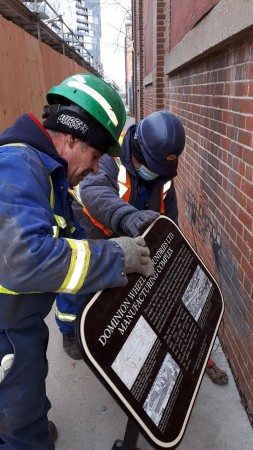If this was the preamble to a “For Openers” podcast (now there’s an idea!), instead of just words on a page, I’d start each episode with 15 to 20 attention-grabbing seconds of arrestingly musical noise. Then, once I had your attention, I’d lure you further in with a few carefully scripted off-the-cuff remarks, like these, as to why that particular soundbite was the perfect lead-in to this particular episode.
Next, I’d drop in a choice quote about the snippet we’d just heard (“It’s a sort of bizzaro polka with some incredible combinations of sounds and, as you can see from the smiles of the musicians’ faces, a treat to perform.”) After that, we’d listen to the whole piece (about five minutes). And after that, the big reveal – “my guest this episode is …” And away we’d go. No more script, and only a few holds barred.
If this were a podcast, by now I’d have told you that today’s opening soundbite (and the choice quote) come courtesy of percussionist Ryan Scott, director of Continuum Contemporary Music, one of several presenters around (a topic for another time) who have really latched onto the e-letter, with its capacity for embedding music, as fundamental to maintaining contact with their audiences.
The pandemic-inspired Continuum newsletter I found this piece of music in is called “Throwback Thursday”. It features performance videos from back in the day when videos like this were the icing on the cake, not the cake itself – more like souvenirs, for those who were there or wish they had been; moments in real musical time, with live audiences attending on sounds flung live into the air, unfiltered, and the players in turn feeding off the energy of that attentiveness.
This particular “Throwback Thursday” segment revolves around a Continuum concert from almost a decade ago (February 12 2012) titled ORGANized. It took place at the Music Gallery, back in the Music Gallery’s St. George-the-Martyr days. The clip, I’d have explained by now, is the premiere performance of a commissioned work titled Remix for Henk, which opened the concert. And I’d have mentioned that not only did the piece set the tone for the evening, but the whole evening would likely not have happened had the composer of the piece not introduced Scott and his co-director Jennifer Waring to Henk de Graauw in his shed in Bramalea … . (But that’s their story, not mine.) And then, if this were a podcast, we’d listen to the whole piece, right through (five minutes).
After that – the moment you’d have been waiting for – I’d introduce my guest: Richard Marsella, composer of Remix for Henk, executive director of Regent Park Community Music School, the eponymous “Friendly Rich” of the band Friendly Rich and the Lollipop People (you can look them up). And, drumroll please, the writer of a community arts story in the current issue of The WholeNote, on the post-pandemic community-building potential of musical playgrounds.
I’d probably start by asking my guest to connect the dots: from the music he composed for Continuum almost a decade ago, inspired by Henk de Grauuw’s musical workshed, to the piece he just wrote for us, inspired by post-Hurricane Katrina reconstruction in New Orleans. After that? We’d gallop off in all directions. If it worked, you’d be left with some things to think about in terms of the nature of community arts, as well as suggestions for other samples of arrestingly musical noise to go look for.
If this were a full-fledged launch party for the current issue, to take the podcast idea one step further, there would be way more planning involved, and a compelling argument for inviting supporters of our magazine, like you, to join the audience (live and/or virtual, as permitted) at some appointed moment in real time, for the event. There would also for sure need to be more than one guest, given the range of content the issue covers.
In any issue of the magazine, like the one you have just started reading, figuring out a running order that connects the dots is always a challenge – figuring out how to paint a larger picture, without compromising the integrity of each separate piece. A bit the way good concerts do. But a launch party like this would be a whole other challenge, and one that, come to think of it, I’d probably be lousy at, given the kind of choreography required for the kind of occasion it would need to be in order not to crash and burn. I get too easily distracted by delightful coincidences.
In this case, for example, I’d be obstinately insisting to my co-curators that the next guest after Marsella has to be Max Christie and his story about Ottawa’s SHHH!! chamber duo, which digs into why the things that make small indie ensembles most vulnerable right now will very likely be the things that will help them bounce back faster.
Why? Obviously because, as it happens, clarinetist Christie shows up as a member of the Continuum ensemble in Remix for Henk! It’s the kind of segue I find as irresistible as the Sunday New York Times crossword. “You can’t plan coincidences like that one,” I’d be arguing. “Yeah, but so what?” someone would need to be brave enough to say to me.
I am not for one moment suggesting, by the way, that eight or nine WholeNote launch parties a year is on the agenda. But it sure sounds like a good idea for the launch of Volume 27 in the fall.
So let’s pretend for a moment: that these next couple of hundred words are the final paragraphs of my opening remarks at an upcoming Volume 27 season launch party (date to be confirmed): “An Evening with the WholeNote” (virtual and real).
We’ve bumped elbows with some of you, live at the door, on the way in, and informed you that there’s an $8.00 cover charge for the event. You’ve happily paid, and some of you have even said keep the change, it’s a good cause. And we’ve said thank you.
Others of you, dozens of dozens, have arrived at the venue through some virtual portal and paid your $8.00 cover charge* some other way (a three-issue subscription is $24, for example). Whichever way you bought in for your $8.00, you did. So thank you for that.
The important thing is you are here, in spirit, sharing a musical moment in common time, witnessing the attentiveness of a live audience responding to music carried through live, virus-load-reduced, shared air.
And then I’d wrap up my remarks by saying “a warm welcome, dear friends, to Volume 27 no 1. Who the hell would have dared hope, a year ago today that we’d make it this far.”
“Because that’s what this is all about, isn’t it? Gathered here today we are a microcosm of the “cultural ecology” without which the titans of our so-called “cultural industries” would have no source of sustenance.”
It’s a picture we try to paint every issue, including this one.
publisher@thewholenote.com
*As for the $8.00 cover charge, if you already think it’s a good idea, you don’t have to wait till September. Contact our circulation department and jump in right away, with a three-issue subscription (as some of you already have done, so thank you for that.) Your $24 will take you all the way to September 14, 2021, Volume 27 no 1. And you will have helped us get there.
publisher@thewholenote.com
 “You have to understand that no one puts their children in a boat unless the water is safer than the land.”
“You have to understand that no one puts their children in a boat unless the water is safer than the land.” 



